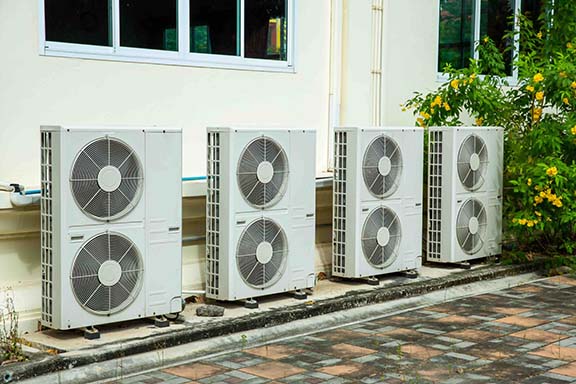
Air conditioning has become an essential part of modern life, providing comfort and relief from scorching temperatures. As the global demand for air conditioning rises, so does its carbon footprint. Actually, air-conditioning units predominantly rely on refrigerants, specifically hydrofluorocarbons (HFCs), to cool indoor spaces.
HFCs are potent greenhouse gasses, with global warming potentials thousands of times higher than carbon dioxide (CO2). When released into the atmosphere, these gasses trap heat, contributing to global warming and climate change. As we all know that air conditioners consume vast amounts of electricity to function, especially during peak summer months.
In many regions, this electricity comes from power plants that burn fossil fuels like coal and natural gas. These power plants are major sources of CO2 emissions, exacerbating the environmental impact of air conditioning systems. The extensive use of air conditioners in urban areas also contributes to the urban heat island effect.
In the heart of the city, buildings soak up the sun’s warmth like sponges, making the city heat up like an oven. This triggers a chain reaction - people crave more cooling, leading to increased energy use and pollution. As a result, our planet’s temperature rises, bringing on more wild weather and hurting precious natural spaces. To take on climate change, we must shrink the carbon footprint of air conditioning.
Central idea of carbon footprint
A carbon footprint represents the total amount of greenhouse gasses, primarily carbon dioxide, released into the atmosphere as a result of human activities such as energy consumption, transportation, and production. In today’s context, understanding and reducing our carbon footprint is of utmost importance due to the escalating threat of climate change.
As our planet faces unprecedented environmental challenges, measuring and mitigating our carbon footprint plays a crucial role in curbing global warming, preserving ecosystems, and ensuring a sustainable future for generations to come.
Solutions for a Greener Cooling Future
Each notch on your AC thermostat impacts your environmental footprint. Consider if living in freezing temperatures is truly necessary. Opt for a dehumidifier too, as it’s often the humidity, not just the heat, that becomes unbearable. A mindful approach to cooling can make a positive difference for our planet.
If we take care about regular maintenance of air conditioning systems can significantly improve their efficiency. Simple tasks like cleaning filters, sealing leaks, and maintaining proper airflow reduce energy consumption and emissions. Also thanks to new technologies nowadays a lot of companies are in the market which provide HFOs and its similar fluorinated materials in cooling devices.
The governments and industry players must promote the transition from HFCs to more environmentally friendly refrigerants like hydrofluoroolefins (HFOs) or natural refrigerants such as hydrocarbons (HCs) or ammonia.
In addition, the advancements in technology have led to the development of energy-efficient and sustainable cooling options like evaporative coolers, heat pumps, and geothermal cooling systems offer viable alternatives that minimize environmental impact.
Let’s not overlook the importance of our living spaces and buildings’ design. Architects and urban planners have the power to integrate smart cooling methods into their creations. These techniques involve utilizing natural ventilation, clever shading, and reflective materials, which can lessen the reliance on energy-intensive cooling systems.
We also have to think a bit more about implementing demand-side management strategies, it can help balance peak electricity consumption and reduce strain on power grids during hot periods. Also encouraging consumers to use air conditioning more responsibly, especially during peak hours, can lead to substantial energy savings.
The carbon footprint of air conditioning may be significantly reduced with the help of governments throughout the globe. They may lead the sector toward a more ecologically responsible course by implementing stronger controls on refrigerant consumption, creating energy efficiency requirements, and giving incentives for adopting sustainable cooling technologies.
Air conditioning is undeniably a lifesaver during hot spells, but its widespread usage comes with significant environmental consequences. Understanding the carbon footprint of cooling systems is essential for acknowledging their impact on climate change and taking effective steps to minimize it.
By embracing sustainable cooling technologies, promoting energy efficiency, and transitioning to environmentally friendly refrigerants, we can strike a balance between comfort and ecological responsibility, ensuring a greener and cooler future for generations to come.







